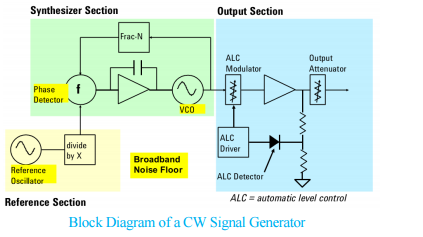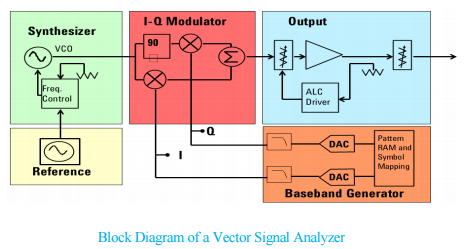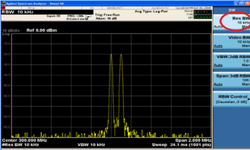Signal Generator
A signal generator is an electronic device that generates repeating or non-repeating electronic signals in either the analog or the digital domain.
The most commonly used signal generators are Continuous Wave (CW) signal generator and Vector Signal Generator.
Continuous Wave SIGNAL GENERATOR, block diagram is shown below.Here RF CW source splits into three sections: reference, synthesizer, and output. The reference section supplies a sine wave with a known frequency to the phase-locked loop (PLL) in the synthesizer section. Its reference oscillator determines the accuracy of the source’s output frequency. The synthesizer section produces a sine wave at the desired frequency and supplies a stable frequency to the output section
Creating a VECTOR SIGNAL GENERATOR simply involves adding an IQ modulator to the basic CW generator. To generate baseband IQ signals, a baseband generator takes binary data containing the desired “information” to be transmitted, maps it to digital symbols and then to digital I and Q signals, converts the digital IQ signals to analog IQ signals, and sends them to the IQ modulator to be coded onto the carrier signal. The same thing we can see in the block diagram of a vector signal generator. After the data undergoes symbol mapping, the digital signals are digitally filtered using two sets of filters in the baseband generator.
The filters are designed to limit the bandwidth of the I and Q symbols and slow down the transitions between symbols. Many types of baseband filters exist, with each having different attributes that must be set in the signal generator. Common filter types are Root Raised Cosine, Gaussian, and Rectangular.
A VECTOR SIGNAL GENERATOR is used to generate the complicated baseband modulation signals required to modulate the RF signal i.e. GSM, W-CDMA, Wifi, LTE signals can be generated from this instrument.
It is generally used in designing, testing, troubleshooting, and repairing electronic devices.
LTE Measurements using signal generator
In general terms, signal generators generates the signal related to any technology like GSM, W-CDMA, Wifi or LTE at some power at particular frequency to test the device’s performance. To generate a particular technology signal, suppose LTE signal, there is a need of LTE signal generation personality in instrument. If have a signal generator instrument, then you have to buy licenses for that LTE personality in that instrument, then LTE signal will be generated. There are many types of licenses are available from manufacturer like uplink TDD, downlink TDD, uplink FDD, downlink FDD etc. And if you get suppose LTE FDD downlink licenses, then you can further configure other LTE parameters in the signal generator like PAPR of the signal, number of resource blocks filled, FFT rate, bandwidth etc. Depending upon the type of requirement, licenses are purchased to cut the cost of buying the whole system.
Manufacturers
Four prominent VNA manufacturers are Keysight (previously Agilent Technologies), Tektronix, Anritsu, and Rohde & Schwarz.
Summary
Signal generators are able to generate a large variety of signals for measurements and this means that they are an invaluable tool for the RF design development and test laboratories.






